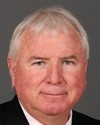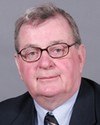Mr. Chair, honourable members, and guests, thank you very much for the invitation to appear before you this afternoon. It's been three years since I had the last opportunity to address the Standing Committee on National Defence, back in March 2003. It's nice to see some familiar faces. Ms. Gallant is here. Mr. Bachand.
Ironically, we will see how many of these issues we discussed then remain with us today.
I want to note that my appearance today was only confirmed on Monday, so my apologies. Normally, we would have provided you with advance copies of our brief in both official languages, but there were some materials distributed earlier; a report called Boots on the Ground, which we released a few weeks ago, has made its way into people's mailboxes.
In the past few weeks, Foreign Affairs Minister Peter MacKay has appeared before both the Senate and the House of Commons defence committees, and in each instance, some of the research that the Polaris Institute has contributed to the national debate on Afghanistan has arisen in the discussions. Not surprisingly, Mr. MacKay has disagreed with our findings, and I'd like to take this opportunity to set the record straight on the topic today, as well as address some of the other assertions made in those presentations.
I invite questions from you for further clarification.
On May 17, the Polaris Institute released a report written by our associate researcher, Bill Robinson, called Boots on the Ground: Canadian Military Operations in Afghanistan and UN Peacekeeping Missions. The report built upon a brief we presented to the Commons finance committee last fall during its pre-budget consultations. That report was entitled It's Never Enough: Canada's alarming rise in military spending, and I've brought English and French copies of that brief with me here today.
At your last meeting, on June 6, Minister MacKay told you that the total expenditures of Canada's multi-faceted engagement in Afghanistan to date amounted to approximately $2.3 billion, that the DND portion of that is $1.8 billion, and “that is an incremental cost of Canadian Forces operations in or related to the Afghanistan mission itself”, he said.
I'm sure that members of this committee would also like to know the full costs of the mission. Minister MacKay's figures represent the incremental costs of the mission and exclude personnel costs. Add soldiers' salaries, overtime, and bonuses, and the full cost of the commitment exceeds $4.1 billion.
Unfortunately, we do not have the list of specific missions Minister MacKay used in calculating that figure, but it's likely similar to the list of missions we documented in our report, Boots on the Ground. Likewise, our report calculated that the incremental cost of these missions since fall 2001 is $2.6 billion, according to DND figures, so we're in the same general ballpark with Minister MacKay's figures. In our report we included both the full cost and the incremental costs, because while both are valid, they do measure different things, and I should note that the Department of National Defence uses both accounting methods in its planning.
Minister MacKay and others would argue that the lower incremental figure should be used, because the soldiers would have to be paid anyway. That's true, but the defence budget is rising precipitously because of the demands to recruit, train, and deploy more troops abroad; therefore, assessing the costs of the missions should take into account their full cost, not just the price of gasoline and ammunition consumed in Afghanistan.
That brings me to the trend in Canada's overall military spending. In our brief to the finance committee last fall we explained that Canada's current level of military spending is already very high by NATO standards.
At this point I'll just refer you to our slide here. These figures come from NATO itself. We have outlined the top seven spenders in NATO. There are 26 members. Where does Canada fit in terms of real dollars? Number seven. These are NATO figures. I include Russia there, as NATO does, just by comparison. That's why you see that there. Canada, at $11 billion in U.S. dollars for 2004, is seventh highest among the 26-member alliance. Globally, we are fifteenth highest. Even today we are a very high military spender.
In the coming few years, as a result of the last two budgets, which have set Canada's military spending on a rise at such a precipitous rate, it almost literally leaps off the chart.
Let me go to the next slide and show you the trends in military spending. In 2005-06 our military spending is about $15 billion. This is all in 2005 dollars, and they've all been adjusted, so we're comparing apples to apples. This goes from 1980 up until the current budget of 2005. You see a steep increase under the Trudeau years. This is the Mulroney government here, and then of course the end of the Cold War in 1989-90. And here we experienced the peace dividend and reductions in military spending up until the end of the 1990s.
At the same time, this is when the federal budget began posting surpluses. You can see defence spending has been put back into the military budget up until the point where we're almost even to the point at which we were at the end of the Cold War. The day the Berlin Wall fell, Canada's spending has almost achieved that same level. The 2005-06 spending, which is about $15 billion, is already just 5% below spending at the end of the Cold War. Within two years we'll exceed what we were spending then, having clawed back the entire post-Cold War peace dividend.
With the increases announced in the Liberals' 2005 budget of $12.8 billion over five years, combined with the additional topping up of the Conservatives in the last budget of an additional $5.3 billion, Canada's military spending will reach $21.5 billion by the end of the decade. Let me just put that on the map for you. We'll add those increases. That's where Canada's military spending is headed in the next few years, well over $20 billion, practically off the chart. Again, I remind you, we are comparing apples to apples. These are all adjusted dollars updated to the last budget. This is an increase of 43.3% over today's spending. By comparison, it will put Canadian military spending at a higher level than any amount of spending in adjusted dollars since the Second World War.
The main driver of this high level of military spending is the perceived need to make our forces more interoperable with U.S. forces, to assist in the U.S.-led war on terrorism. I might remind you that the U.S. level of spending is higher than that of the rest of the world combined and is arguably bankrupting their country.
This brings us back to Afghanistan. The mission in Afghanistan is really a proving ground for greater military integration with U.S. forces. Again, Minister MacKay did his best to portray our current role as a peace-building humanitarian mission and anything but Canada's contribution to the U.S.-led war on terrorism. He also told this committee that our engagement is intended to build a stable, secure, democratic, and self-sufficient Afghanistan. But this diverges from the reasoning the government gave in the Speech from the Throne this year, which said we are in Afghanistan to “defend our national interests, combat global terrorism and help the Afghan people”. The government defined its view of the country's national interest as building stronger multilateral and bilateral relationships, starting with Canada's relationship with the United States.
The mission in Afghanistan has crowded out all other possible international roles for our military. In the last five years, the Afghan mission has consumed 68% of our military spending on international missions. While Minister MacKay portrayed the mission as supporting the UN, the truth is that during the same five-year period the full cost of our contribution to UN peacekeeping was only $214 million, or 3% of our military spending on international missions.
Once a proud top ten contributor of soldiers to UN blue helmet missions, today we are far down the list at 50, just behind Romania and ahead of Mali. In terms of actual soldiers, we provide only 59 peacekeepers. You can fit all of our UN peacekeeping troops on a single school bus.
Meanwhile, in Afghanistan, we are, as I would argue, seeing the Americanization of the Canadian Forces as we adopt U.S. war-fighting tactics. For instance, the reconstruction effort, which is laudable, is only a small part of our role. Only 250 of the 2,300 troops in Afghanistan are devoted to our provincial reconstruction team, while more than 1,000 are in the Canadian battle group engaged in the U.S.-style search and destroy missions in the countryside. And as you know, we are currently under U.S. command as part of Operation Enduring Freedom. This became painfully obvious to Canadians recently when Canadian commanders had to admit the decision to bomb and strafe a school in Azizi, killing more than a dozen civilians and children along with Taliban fighters, came from their American superiors.
At some time in the coming months we will move our troops back under NATO's ISAF command structure, but there's no fixed date. Yet committee members may have felt that Minister MacKay was conflating these two missions, the U.S. Operation Enduring Freedom and NATO ISAF, by arguing that one would be a continuation of the other. This would be news to NATO, which sees the two missions as very distinct. First, NATO has a clear UN mandate—which is different from being UN-led. It's not a blue helmet mission, but it does have a UN mandate, which is maybe the next best thing, while Operation Enduring Freedom does not. Second, NATO is involved in a peace support mission, not a counter-terrorism mission.
When asked about the two missions by the Globe and Mail recently, NATO Secretary General Jaap de Hoop Scheffer said:
We'll keep the mission distinct from [Operation] Enduring Freedom.... I do, we do, and the allies do consider this a NATO mission....
The fundamental difference is that Operation Enduring Freedom is basically a counter-terrorism, counter-insurgency operation and ISAP is a stabilization mission.
This is an extremely important point, because the debate is whether or not the counter-terrorism mission Canada is conducting with the U.S. is fundamentally incompatible with NATO's peace support objectives. As the NATO Secretary General said, it's about stabilization, reconstruction; it's about winning hearts and minds. But what must be a growing concern to this committee is the number of reports emerging from Afghanistan indicating that we are losing the battle for hearts and minds and the Taliban is winning.
Two weeks ago former U.S. Secretary of Defense John J. Hamre told the New York Times that Afghanistan is the sleeper crisis of the summer. In the past two weeks the Taliban have appeared in unprecedented numbers in groups of up to 300 men. The U.S. is now rethinking its decision to reduce their numbers in Afghanistan and has delayed the final handover to NATO that was scheduled for the end of this year.
More bad news came yesterday from the British think tank, the Senlis Council. Based on extensive interviews on the ground in Afghanistan with Afghan farmers, they've concluded that the aggressive military interventions so far by U.S. troops and their supporters have meant the coalition forces have lost the support of local people. The report adds that people have gained little from the occupation, especially in the south, where so much was promised and so little was delivered. The council estimates that in Helmand province, which the British are moving into now, next door to Kandahar, 80% of the people support the Taliban.
In terms of attacks, in 2004 there were just five suicide attacks, while there have been 21 in just the first semester of 2006, and the attacks are more sophisticated and lethal. We've already seen that Canadians are finding their armoured Jeeps are no longer sufficient defence and are now relying almost exclusively on the LAV IIIs. How long before the Taliban will be able to defeat their armour?
Again, Minister MacKay reiterated a multi-faceted approach to Afghanistan that included development and political support as well as our military role. However, it is the political approach that receives the least amount of attention, and it must be attended to right away, before it is too late.
Last week I had the privilege of accompanying Dr. Seddiq Weera at a press conference here on Parliament Hill. Dr. Weera is a diplomat and an Afghan-born Canadian who was imprisoned for more than four years under the Soviet occupation of Afghanistan. Later he came to Canada to study at McMaster University and the University of Toronto. Now he's advising the Karzai government. At that press conference he urged the Canadian government to support a renewed peace process that will bring all the political elements in Afghanistan together to the table, including the Taliban. He has spoken with the Taliban leaders and has said he has a list of those leaders who are prepared to begin a dialogue.
But according to Minister MacKay earlier this week, as he said, “insurgents are not interested in peace”. I would argue, and also Dr. Weera would argue, that it's this kind of enemy-centric view that will be our undoing, because the longer the combat mission goes on, the more it helps the Taliban and al-Qaeda find more recruits. Our own military leadership has said that every time we kill one of them, it helps them recruit 10 more. And in the U.S. last summer, Defense Secretary Donald Rumsfeld himself said we need to start talking with the most moderate elements within the Taliban.
Here is an influential Afghan-born, Canadian-educated diplomat who can help us take a lead role in this country. And what is the government's response? Foreign Affairs officials cancelled their meeting with him at the last minute. One has to ask whether the Canadian government is interested in finding a diplomatic solution to Afghanistan. Will we learn that our combat role will be as fruitless as a struggling man up to his neck in quicksand? If so, I fear Afghanistan will become Canada's Iraq.
In conclusion, the Polaris Institute urges this committee, first of all, to advise the government that our role in the U.S.-led combat mission is ultimately a mission impossible. We need to assess the success of the military mission objectively and work with our NATO allies to bring a quick end to Operation Enduring Freedom in Afghanistan.
Second, let's support the work of Dr. Weera and others in Afghanistan to pursue a diplomatic solution to the Afghan, essentially, civil war.
Finally, we must return our military commitment to the United Nations and answer positively the next time the UN comes asking for contributions of blue helmet peacekeepers.
Thank you very much.





